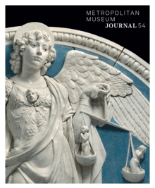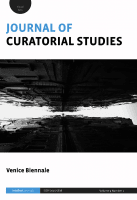
METROPOLITAN MUSEUM JOURNAL
metrics 2024
Connecting Ideas for a New Era in Museums
Introduction
METROPOLITAN MUSEUM JOURNAL, published by the University of Chicago Press, serves as a vital platform for researchers, professionals, and students in the fields of Conservation and Museology. With an ISSN of 0077-8958 and an E-ISSN of 2169-3072, this journal emphasizes the importance of scholarly discourse on art preservation and museum practices. Although it currently holds a Q4 ranking in both Conservation and Museology according to the 2023 category quartiles, the journal continues to contribute to advancements and discussions within these vital fields. Located in Belgium, the journal's mission is to illuminate best practices, innovative techniques, and significant case studies that inform the future of museum work. As an indispensable resource for those dedicated to the arts and humanities, METROPOLITAN MUSEUM JOURNAL fosters a community for exchanging ideas and insights, crucial for the ongoing development and understanding of museum methodologies.
Metrics 2024
 0.10
0.10 0.20
0.20 0.20
0.20 5
5Metrics History
Rank 2024
Scopus
JCI (Web Of Science)
Quartile History
Similar Journals

JAHRBUCH DER BERLINER MUSEEN
Advancing Knowledge in Art and HistoryJAHRBUCH DER BERLINER MUSEEN, published by GEBR MANN VERLAG, is a prestigious journal dedicated to the study and presentation of art, culture, and history as showcased in Berlin's museums. With a rich history dating back several years, this journal serves as a vital resource for researchers, professionals, and students interested in the multifaceted aspects of museum studies and cultural heritage. Although its coverage in Scopus was discontinued after 2010, it remains a significant platform for disseminating scholarly articles, exhibition reviews, and discussions surrounding museum practices and exhibitions in Germany. The journal not only contributes to academic discourse but also acts as a bridge between scholarly research and public engagement in cultural institutions. For those keen on exploring the intersection of art and scholarship within the German context, JAHRBUCH DER BERLINER MUSEEN represents an invaluable reference point.

Art-Sanat
Unveiling the Depths of Visual Arts ScholarshipArt-Sanat is a distinguished open-access journal published by the Research Institute of Turkology at Istanbul University, focusing on various facets of art history, visual arts, and cultural heritage. Since its open-access launch in 2017, the journal has been dedicated to promoting scholarly communication and disseminating innovative research within the fields of Art History, Archaeology, and Conservation. With an impact factor that highlights its increasing prominence—ranking in the Q1 quartile for History and Visual Arts and Performing Arts—Art-Sanat provides a platform for researchers, professionals, and students to share high-quality studies. The journal's commitment to transparency and accessibility assures that its contributions are available to a global audience, fostering a community of inquiry in the rich and diverse artistic landscapes of Turkey and beyond. With a robust ranking in Scopus, it stands as a noteworthy resource that advances scholarly engagement and interdisciplinary dialogue in the arts and humanities.

Taida Journal of Art History
Decoding the evolution of artistic expression in Taiwan.Taida Journal of Art History, published by NATIONAL TAIWAN UNIVERSITY, GRADUATE INSTITUTE OF ART, is a pioneering academic journal dedicated to the exploration and critique of art history, particularly within the unique cultural context of Taiwan. Since its inception in 2018, the journal has become an important platform for scholarly discourse, offering insights into the evolution of visual arts and performing arts, alongside comprehensive studies in history. With an ISSN of 1023-2095, it currently ranks within the Q4 category in Arts and Humanities (Miscellaneous) and the Q3 category in History and Visual Arts and Performing Arts, indicating its growing influence in these fields. Researchers, professionals, and students alike can benefit from its rigorous peer-reviewed articles that bridge theoretical frameworks with practical applications, making it an essential resource for those engaged in the arts and humanities. This commitment to fostering academic excellence is reflected in its Scopus rankings, where it stands at Rank #338/667 in Visual Arts and Performing Arts and Rank #1027/1760 in History. Engage with the Taida Journal of Art History to gain deeper insights into the evolving narratives of artistic expression.

Quiroga-Revista de Patrimonio Iberoamericano
Unveiling the Essence of Ibero-American HeritageQuiroga-Revista de Patrimonio Iberoamericano, published by UNIV GRANADA, is a distinguished open-access journal dedicated to the fields of conservation, museology, and the visual and performing arts. Since its inception in 2012, the journal has provided a platform for scholars and practitioners to disseminate innovative research and critical discussions pertinent to Ibero-American heritage. With a growing impact, evidenced by its category quartiles ranking—Q3 in Conservation and Q2 in both Museology and Visual Arts and Performing Arts—as well as its Scopus rankings, Quiroga serves as an essential resource for researchers, professionals, and students who engage with the complexities of cultural preservation and artistic expression. The journal’s commitment to open access ensures the widespread availability of knowledge, fostering academic dialogue and collaboration within the global community. For inquiries, the journal can be reached at their offices located in Granada, Spain.

BURLINGTON MAGAZINE
Celebrating Creativity Through Scholarly DiscourseBurlington Magazine is a prestigious scholarly journal dedicated to the study and appreciation of visual arts and performing arts. Established in 1980 and published by Burlington Mag Publ Ltd, this UK-based journal offers a platform for innovative research and critical discussion, attracting a diverse audience of researchers, professionals, and students. Although it currently holds a Q4 ranking in Visual Arts and Performing Arts according to the 2023 Category Quartiles, it provides valuable insights into emerging trends and classical themes within the arts. The journal, with its ISSN 0007-6287 and E-ISSN 2044-9925, features a range of articles, reviews, and in-depth analyses, fostering scholarly discourse and enhancing the understanding of visual and performing arts. While there is no Open Access option available, readers can access its rich repository of knowledge through institutional subscriptions, making it an essential resource for anyone passionate about the arts. Whether you are a scholar seeking the latest research or an enthusiast eager to explore artistic developments, Burlington Magazine stands as an invaluable asset in the field.

Laboratorio de Arte
Championing Open Access for Creative MindsLaboratorio de Arte is an esteemed journal published by UNIV SEVILLA, EDITORIAL, specializing in the interdisciplinary fields of Arts and Humanities, Conservation, Museology, and Visual Arts. With an impactful presence in research since its inception, the journal has been open access since 2006, promoting the free dissemination of knowledge and fostering academic dialogue among scholars, professionals, and students. The journal adheres to rigorous academic standards, reflected in its categorization within the Q2 and Q3 quartiles across various disciplines, and its commendable rankings in Scopus make it an essential resource for those engaged in the arts. The h-index for this journal showcases its contribution to the field, further solidifying its importance in contemporary research. As it continues to evolve through 2023 and beyond, Laboratorio de Arte serves as a vital platform for innovative thoughts and practices within the vibrant landscape of artistic and cultural studies.

Journal of Curatorial Studies
Navigating Contemporary Challenges in Curatorial PracticeThe Journal of Curatorial Studies, published by INTELLECT LTD, is a leading scholarly journal dedicated to advancing the field of curatorial practice across the visual arts, museology, and conservation. With an ISSN of 2045-5836 and an E-ISSN of 2045-5844, this UK-based publication has been a vital resource since its establishment in 2016, covering significant developments and innovative research until 2023. As an academic platform, it seeks to foster interdisciplinary dialogue among curators, artists, and scholars, exploring contemporary challenges and methodologies within its scope. Ranking in the Q4 category for Conservation and Q3 for both Museology and Visual Arts and Performing Arts, the journal plays an essential role in elevating discourse and practice within these fields. Researchers and practitioners alike will find valuable insights that reflect the dynamic nature of curatorial studies and its profound influence on cultural heritage and contemporary art. Despite its recent establishment, it holds a commendable position in the Scopus Rankings, aiming to provide a rich repository of knowledge and practical guidance in its quest to innovate curatorial practices.

South African Journal of Art History
Exploring the Rich Tapestry of South African Art HistorySouth African Journal of Art History is a premier academic publication dedicated to the exploration and critical analysis of art history within the South African context. Published by the Art Historical Work Group South Africa (AHWG), this journal serves as a vital platform for researchers, professionals, and students alike to disseminate innovative research and engage with diverse perspectives on visual culture. With an ISSN of 0258-3542, the journal aims to elevate the study of art history, contributing significantly to the scholarly community's understanding of both local and international art narratives. Although currently not an open access journal, it is committed to high academic standards and in-depth scholarship, ensuring that each article published meets rigorous criteria. As South Africa continues to position itself at the forefront of global art discourse, the South African Journal of Art History stands out as a critical resource for anyone interested in the intersections of art, culture, and history within this dynamic region.

Zivot Umjetnosti
Bridging theory and practice in the world of art.Zivot Umjetnosti, published by the INST POVIJEST UMJETNOSTI - INST ART HISTORY, is a notable Croatian journal that serves as a platform for scholarly discourse in the fields of visual arts, performing arts, and museology. With its inception in 2008, the journal has continued to provide a voice for researchers and practitioners alike, contributing significantly to ongoing conversations in the arts. Despite its current Q4 rank in both Visual Arts and Museology categories—placing it within the 21st and 17th percentiles, respectively—Zivot Umjetnosti is recognized for its commitment to advancing knowledge and fostering critical dialogue. The journal aims to bridge theoretical frameworks with practical applications, making it an invaluable resource for academics, curators, and students engaged in artistic research. While currently operating under traditional access options, Zivot Umjetnosti remains a fundamental publication for those wishing to explore and expand their understanding of the dynamic intersection of art and culture in Croatia and beyond.

METROPOLITAN MUSEUM OF ART BULLETIN
Celebrating Art Through Scholarly DiscourseThe Metropolitan Museum of Art Bulletin is a distinguished periodical dedicated to the study and appreciation of art, particularly within the vast collections of the Metropolitan Museum of Art in New York. Published by the Metropolitan Museum of Art, this journal represents a pivotal resource for scholars, curators, and art enthusiasts alike, exploring diverse topics that span museology and the visual arts. With an ISSN of 0026-1521 and an E-ISSN of 2325-6915, the journal features scholarly articles and insights reflecting the museum's unique collections and exhibitions from 2002 to 2022. Although categorized in the Q4 quartile in both Museology and Visual Arts and Performing Arts, the Bulletin remains instrumental in fostering academic discourse in these fields, regardless of its Scopus rankings. As the world of art continues to evolve, this journal provides critical context and scholarly evaluation that inspire ongoing research and engagement with art institutions.